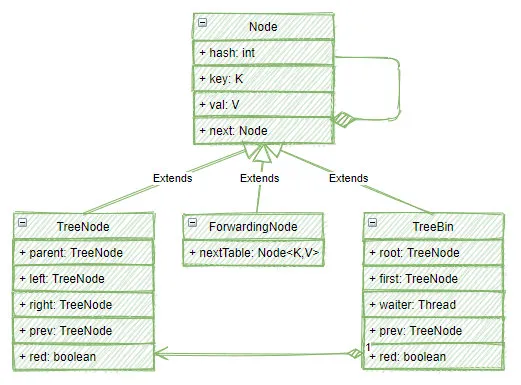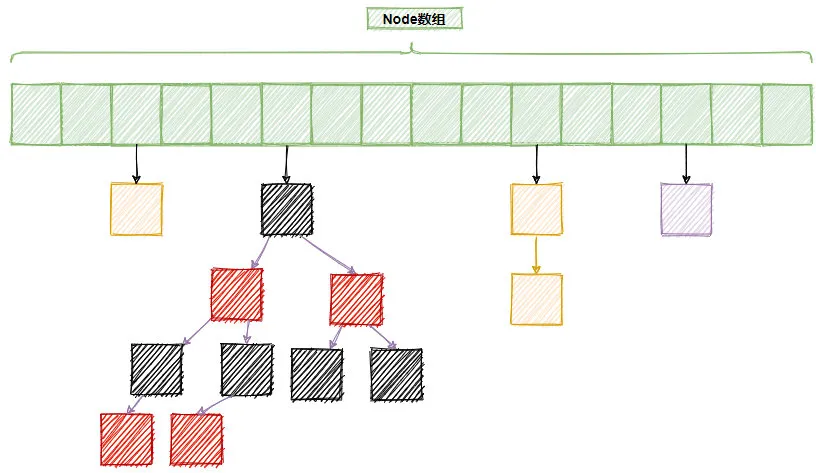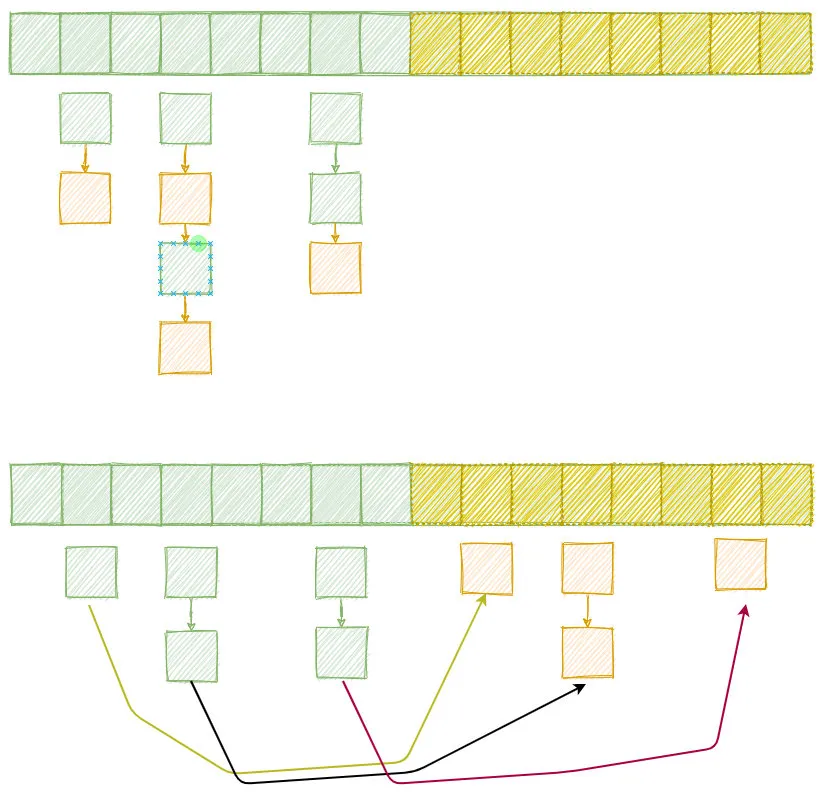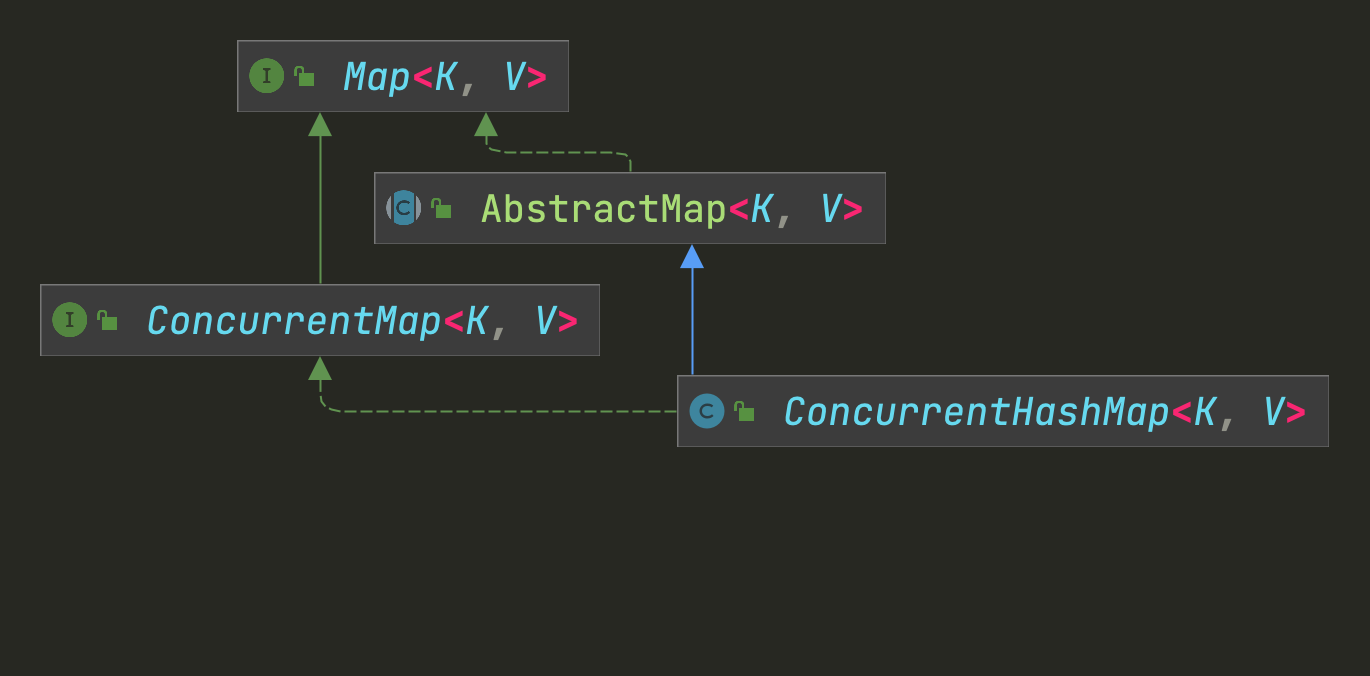ConcurrentHashMap的内部数据结构
重要属性
int sizeCtl
这是一个多功能的字段,可以用来记录参与Map扩展的线程数量,也用来记录新的table的扩容阈值
CounterCell[] counterCells
用来记录元素的个数,这是一个数组,使用数组来记录,是因为避免多线程竞争时,可能产生的冲突。使用了数组,那么多个线程同时修改数量时,极有可能实际操作数组中不同的单元,从而减少竞争。
Node[] table
实际存放Map内容的地方,一个map实际上就是一个Node数组,每个Node里包含了key和value的信息。
Node[] nextTable
当table需要扩充时,会把新的数据填充到nextTable中,也就是说nextTable是扩充后的Map。
以上就是ConcurrentHashMap的核心元素,其中最值得注意的便是Node。
内部类Node
static class Node<K,V> implements Map.Entry<K,V> {final int hash;final K key;volatile V val;volatile Node<K,V> next;Node(int hash, K key, V val, Node<K,V> next) {this.hash = hash;this.key = key;this.val = val;this.next = next;}public final K getKey() { return key; }public final V getValue() { return val; }public final int hashCode() { return key.hashCode() ^ val.hashCode(); }public final String toString(){ return key + "=" + val; }public final V setValue(V value) {throw new UnsupportedOperationException();}public final boolean equals(Object o) {Object k, v, u; Map.Entry<?,?> e;return ((o instanceof Map.Entry) &&(k = (e = (Map.Entry<?,?>)o).getKey()) != null &&(v = e.getValue()) != null &&(k == key || k.equals(key)) &&(v == (u = val) || v.equals(u)));}/*** Virtualized support for map.get(); overridden in subclasses.*/Node<K,V> find(int h, Object k) {Node<K,V> e = this;if (k != null) {do {K ek;if (e.hash == h &&((ek = e.key) == k || (ek != null && k.equals(ek))))return e;} while ((e = e.next) != null);}return null;}}
Node的类结构:
可以看到,在Map中的Node并非简单的Node对象,实际上,它有可能是Node对象,也有可能是一个Treebin或者ForwardingNode。
- ForwardingNode:A node inserted at head of bins during transfer operations.
- ReservationNode:A place-holder node used in computeIfAbsent and compute.
- TreeBin:TreeNodes used at the heads of bins. TreeBins do not hold user keys or values, but instead point to list of TreeNodes and their root. They also maintain a parasitic read-write lock forcing writers (who hold bin lock) to wait for readers (who do not) to complete before tree restructuring operations.
- TreeNode:Nodes for use in TreeBins
一个正常的Map可能是长这样的:
上图中,绿色部分表示Node数组,里面的元素是Node,也就是链表的头部,当两个元素在数据中的位置发生冲突时,就将它们通过链表的形式,放在一个槽位中。
当数组槽位对应的是一个链表时,在一个链表中查找key只能使用简单的遍历,这在数据不多时,还是可以接受的,当冲突数据比较多时,这种简单的遍历就有点慢了。
因此,在具体实现中,当链表的长度大于等于8时,会将链表树状化,也就是变成一颗红黑树。
如下图所示,其中一个槽位就变成了一颗树,这就是TreeBin(在TreeBin中使用TreeNode构造树)。
当数组容量快满时,即超过75%的容量时,数组还需要进行扩容,在扩容过程中,如果老的数组已经完成了复制,那么就会将老数组中的元素使用ForwardingNode对象替代,表示当前槽位的数据已经处理了,不需要再处理了,这样,当有多个线程同时参与扩容时,就不会冲突。
put()方法的实现
public V put(K key, V value) {return putVal(key, value, false);}final V putVal(K key, V value, boolean onlyIfAbsent) {if (key == null || value == null) throw new NullPointerException();//key和value都不能为空int hash = spread(key.hashCode());//将散列的较高位传播到较低位,并将最高位强制设为0,减少冲突int binCount = 0;for (Node<K,V>[] tab = table;;) {Node<K,V> f; int n, i, fh;if (tab == null || (n = tab.length) == 0)tab = initTable();else if ((f = tabAt(tab, i = (n - 1) & hash)) == null) {if (casTabAt(tab, i, null,new Node<K,V>(hash, key, value, null)))break; // no lock when adding to empty bin}else if ((fh = f.hash) == MOVED)//节点正在转发tab = helpTransfer(tab, f);else {V oldVal = null;//加锁进行旧节点的更新synchronized (f) {if (tabAt(tab, i) == f) {//链表if (fh >= 0) {binCount = 1;for (Node<K,V> e = f;; ++binCount) {K ek;if (e.hash == hash &&((ek = e.key) == key ||(ek != null && key.equals(ek)))) {oldVal = e.val;if (!onlyIfAbsent)e.val = value;break;}Node<K,V> pred = e;if ((e = e.next) == null) {pred.next = new Node<K,V>(hash, key, value, null);//头插break;}}}//树else if (f instanceof TreeBin) {Node<K,V> p;binCount = 2;if ((p = ((TreeBin<K,V>)f).putTreeVal(hash, key, value)) != null) {oldVal = p.val;if (!onlyIfAbsent)p.val = value;}}}}//转换成红黑树if (binCount != 0) {if (binCount >= TREEIFY_THRESHOLD)treeifyBin(tab, i);if (oldVal != null)return oldVal;break;}}}addCount(1L, binCount);return null;}
public V put(K key, V value):将给定的key和value对存入HashMap,它的工作主要有以下几个步骤:
- 如果没有初始化数组,则尝试初始化数组
- 如果当前正在扩容,则参与帮助扩容(调用helpTransfer()方法)
- 将给定的key,value 放入对应的槽位
- 统计元素总数
- 触发扩容操作
初始化数组
初始化数据会生成一个Node数组:
Node<K,V>[] nt = (Node<K,V>[])new Node<?,?>[n];
默认情况下,n为16。同时设置sizeCtl为·n - (n >>> 2); 这意味着sizeCtl为n的75%,表示Map的size,也就是说ConcurrentHashMap的负载因子是0.75。(为了避免冲突,Map的容量是数组的75%,超过这个阈值,就会扩容)
参与帮助扩容
else if ((fh = f.hash) == MOVED)tab = helpTransfer(tab, f);
如果一个节点的hash是MOVED,则表示这是一个ForwardingNode,也就是当前正在扩容中,为了尽快完成扩容,当前线程就会参与到扩容的工作中,而不是等待扩容操作完成,这是ConcurrentHashMap高性能的原因。
而代码中的f.hash==MOVE语义上等同于f instanceof ForwardingNode,但是使用整数相等的判断的效率要远远高于instanceof,所以,这里也是一处对性能的极限优化。
将key,value 放入对应的槽位
在大部分情况下,应该会走到这一步,也就是将key和value放入数组中。在这个操作中会使用大概如下操作:
Node<K,V> f;synchronized (f) {if(所在槽位是一个链表)插入链表else if(所在槽位是红黑树)插入树if(链表长度大于8[TREEIFY_THRESHOLD])将链表树状化}
可以看到,这使用了synchronized关键字,锁住了Node对象。由于在绝大部分情况下,不同线程大概率会操作不同的Node,因此这里的竞争应该不会太大。
并且随着数组规模越来越大,竞争的概率会越来越小,因此ConcurrentHashMap有了极好的并行性。
统计元素总数
为了有一个高性能的size()方法,ConcurrentHashMap使用了单独的方法来统计元素总数,元素数量统计在CounterCell数组中:
CounterCell[] counterCells;@sun.misc.Contended static final class CounterCell {volatile long value;CounterCell(long x) { value = x; }}
CounterCell使用伪共享优化,具有很高的读写性能。counterCells中所有的成员的value相加,就是整个Map的大小。这里使用数组,也是为了防止冲突。
如果简单使用一个变量,那么多线程累加一个计数器时,难免要有竞争,现在分散到一个数组中,这种竞争就小了很多,对并发就更加友好了。
累加的主要逻辑如下:
if (as == null || (m = as.length - 1) < 0 ||//不同线程映射到不同的数组元素,防止冲突(a = as[ThreadLocalRandom.getProbe() & m]) == null ||//使用CAS直接增加对应的数据!(uncontended =U.compareAndSwapLong(a, CELLVALUE, v = a.value, v + x)))//如果有竞争,在这里会重试,如果竞争严重还会将CounterCell[]数组扩容,以减少竞争
触发扩容操作
最后,ConcurrentHashMap还会检查是否需要扩容,它会检查当前Map的大小是否超过了阈值,如果超过了,还会进行扩容。
ConcurrentHashMap的扩容过程非常巧妙,它并没有完全打乱当前已有的元素位置,而是在数组扩容2倍后,将一半的元素移动到新的空间中。
所有的元素根据高位是否为1分为low节点和high节点:
//n是数组长度,数组长度是2的幂次方,因此一定是100 1000 10000 100000这种二进制数字//这里将low节点串一起, high节点串一起if ((ph & n) == 0)ln = new Node<K,V>(ph, pk, pv, ln);elsehn = new Node<K,V>(ph, pk, pv, hn);
接着,重新放置这些元素的位置:
//low节点留在当前位置setTabAt(nextTab, i, ln);//high节点放到扩容后的新位置,新位置距离老位置nsetTabAt(nextTab, i + n, hn);//扩容完成,用ForwardingNode填充setTabAt(tab, i, fwd);
下图显示了 从8扩充到16时的可能得一种扩容情况,注意,新的位置总是在老位置的后面n个槽位(n为原数组大小)

这样做的好处是,每个元素的位置不需要重新计算,进行查找时,由于总是会对n-1(一定是一个类似于1111 11111 111111这样的二进制数)按位与,因此,high类的节点自然就会出现在+n的位置上。
get()方法的实现
public V get(Object key) {Node<K,V>[] tab; Node<K,V> e, p; int n, eh; K ek;int h = spread(key.hashCode());if ((tab = table) != null && (n = tab.length) > 0 &&(e = tabAt(tab, (n - 1) & h)) != null) {//数组中的元素就是要找的keyif ((eh = e.hash) == h) {if ((ek = e.key) == key || (ek != null && key.equals(ek)))return e.val;}else if (eh < 0)//调用Node的find方法查找元素return (p = e.find(h, key)) != null ? p.val : null;while ((e = e.next) != null) {//从链表中查找if (e.hash == h &&((ek = e.key) == key || (ek != null && key.equals(ek))))return e.val;}}return null;}
与put()方法相比,get()方法就比较简单了。步骤如下:
- 根据hash值 得到对应的槽位 (n - 1) & h
- 如果当前槽位第一个元素key就和请求的一样,直接返回
- 否则调用Node的find()方法查找
- 对于ForwardingNode 使用的是 ForwardingNode.find()
- 对于红黑树 使用的是TreeBin.find()
- 对于链表型的槽位,依次顺序查找对应的key


